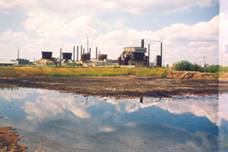The problem
According to the Dzerzhinsk Committee of Environmental Control, the drinking water quality in some residential areas of the city does not meet minimal safety standards. The groundwater in this area was poisoned by Dzerzhinsk's Cold War-era factories responsible for the production of Sarin and VX gas. Chemicals and toxic residuals from those manufacturing sites are present in both ground and surface water.According to figures from Dzerzhinsk's environmental agency, prior to 1998 (and as early as the 1930s) almost 300,000 tons of chemical waste were disposed of haphazardly around the area every year and around 190 separate chemicals were released into the groundwater. The city draws its drinking water from the same aquifers into which old wastes and unused products were pumped.
Current Activity
Following a baseline research project in the area in 2004, Blacksmith, in cooperation with the local government, funded the installation in 2006 of a water treatment system in the village of Pyra (population 4,000), a settlement whose groundwater is highly polluted yet remains the sole source of drinking water. In the longer term, Blacksmith hopes to support local groups and authorities in the design of a large-scale remediation and pollution mitigation plan for the area.In 2004 the local government conducted an initial evaluation of the extent of the groundwater contamination in the city and reviewed subsequent engineering options to bring clean water in to Dzerzhinsk to replace use of the contaminated groundwater source in Gavrilovka and Pyra, two areas of the city. Gavrilovka (population 1,000) is a residential area located 3 kilometers south-east of Syntez - a former producer of tetraethyl lead (a gasoline additive). Piri (population 4,000) is the second area of concern.
In a related water contamination case, the project also aims to design a plan to prevent the release of toxins from the Volosyanikha Canal located in Dzerzhinsk into the Oka river basin, a source of water for Nizhni Novgorod (population 1 million). The canal, identified as a superfund site, is where industrial wastewater from various chemical enterprises has been routinely discharged since the 1930s. Now that many of these industries are no longer in operation, the local groundwater has risen, along with the water level in the canal. This rise in the canal's water level threatens to dump arsenic, mercury, lead and dioxins into the Oka river basin, a source of drinking water for Nizhniy Novgorod.
Outcome
As part of the Dzerzhinsk strategy, Blacksmith has funded a water treatment plant for Pyra, a neighborhood with very poor groundwater. This neighborhood now has clean drinking water.Data File
Pollutants:
Chemicals
Location:
Dzerzhisnk,
Russia
Transmission:
Water
Source:
Chemical Weapons Manufacturing
Report Type:
Project
Project Status:
Success Stories
Pollution Status:
Legacy


